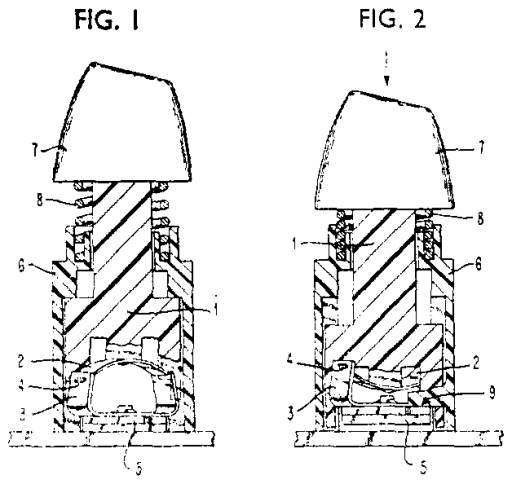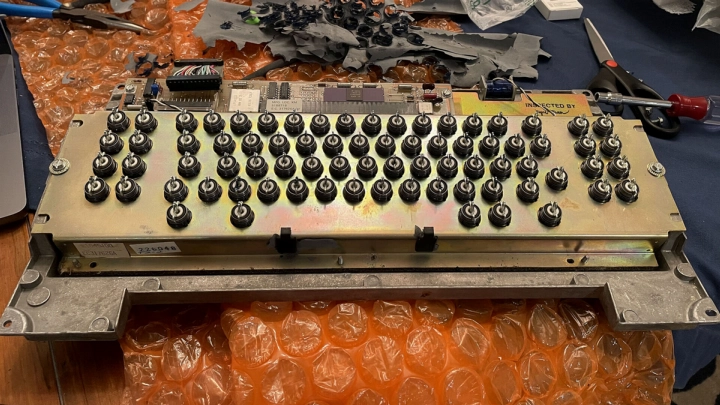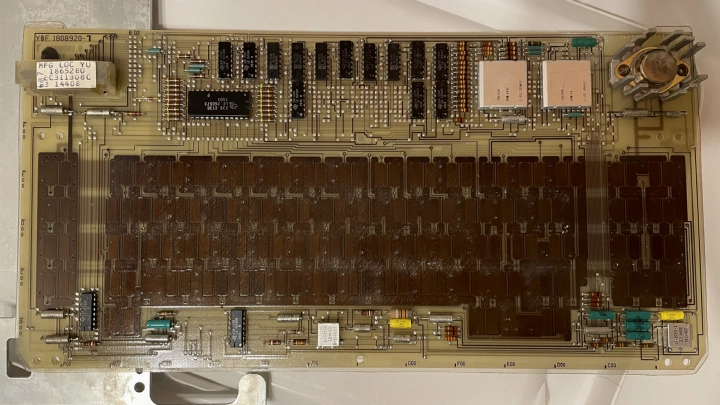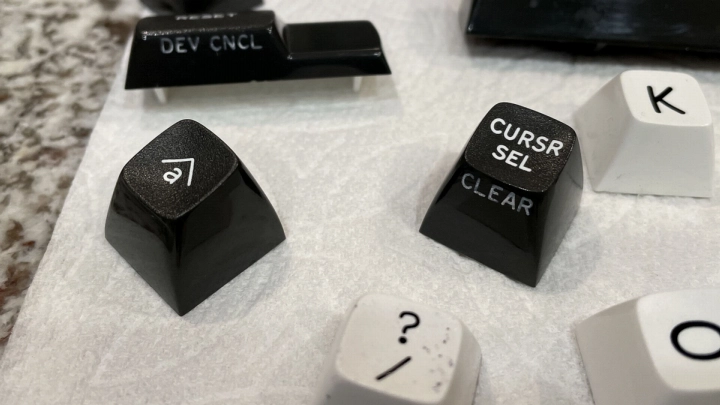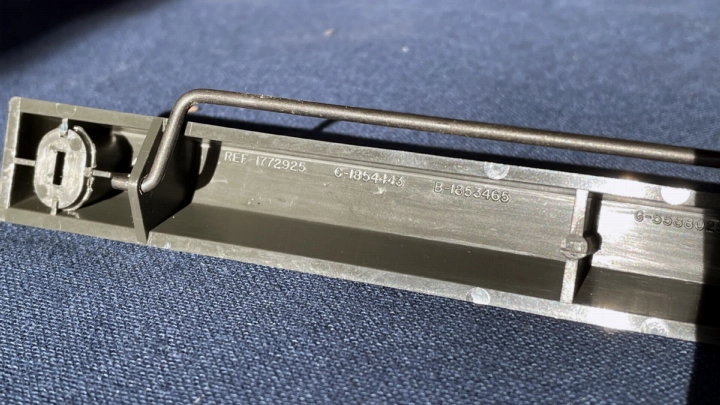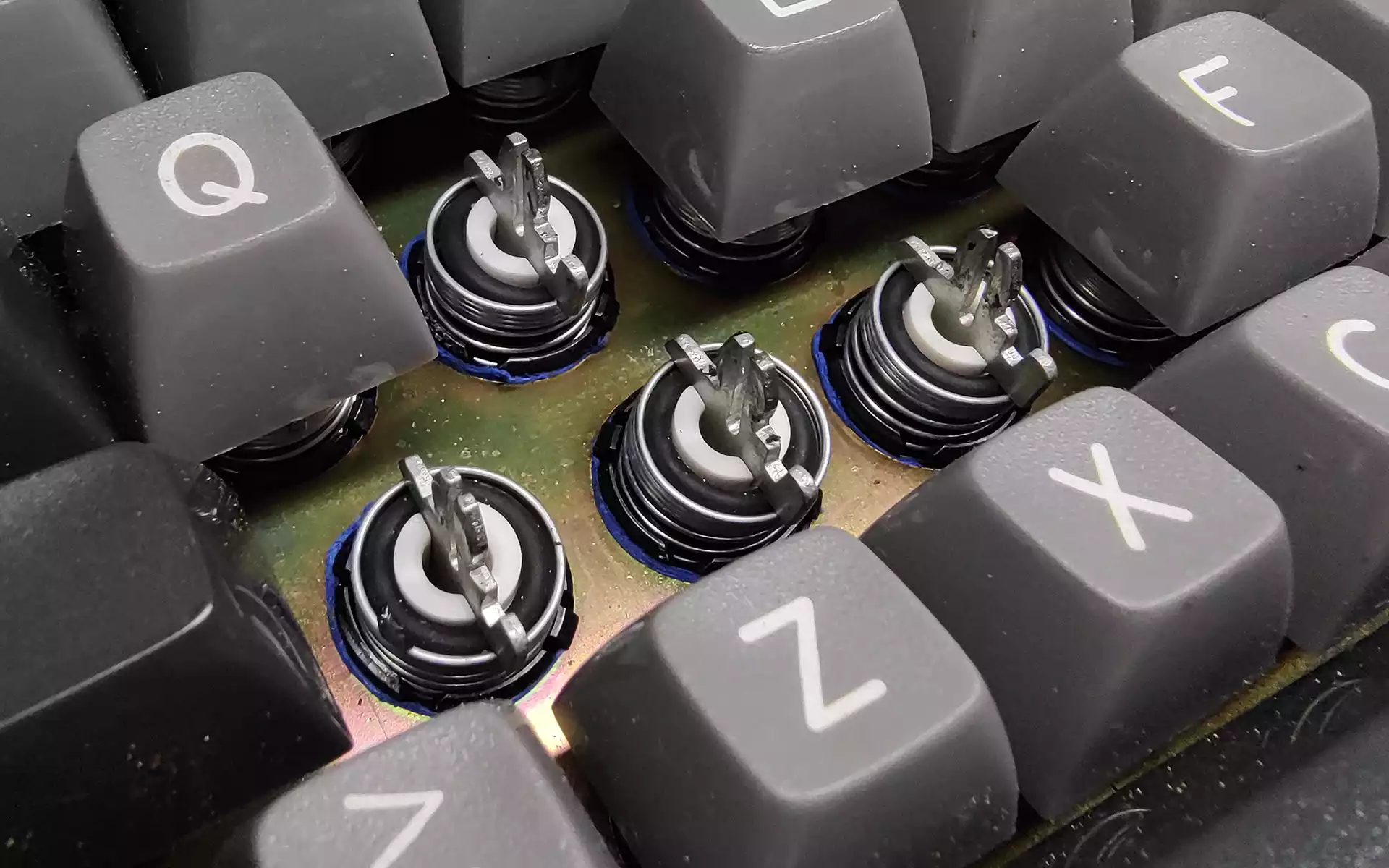- Updated
The IBM switch button with a snap mechanism - the beam spring - was a clicky key-switch employed by IBM throughout the 1970s as their primary keyboard switch mechanism used on most of their keyboards during this period, the IBM Model B family. It was invented by Richard Hunter Harris and Robert John Wolfram[1] and registered as a patent on 24th September 1971[2], put into production by at least the following year with the earliest recorded host keyboard being the IBM 3158 66-key Display Console Keyboard (S370-T1 type Model B) announced in August 1972[3]. IBM beam springs replaced both their own Elastic Diaphgram switch design and supplanted IBM's use of Micro Switch's SW hall effect key-switches. Whilst large by today's standard and containing more parts than the later IBM buckling spring key-switch, the beam spring is well regarded.
Contents
| Switch type | Clicky |
| Sensor type | Capacitance-sensing PCB |
| Keycap mount | Selectric/Model B |
| Total key travel | 3.6mm[4] |
| Peak tactile force travel | 2.7mm[4] |
| Peak tactile force | ~46gf[4] |
| Rated lifetime | 100 million key presses minimum[5] |
| Other features | part-way actuation |
Design
The IBM beam spring was patented as switch button with a snap mechanism in Germany in 1971 and simply toggle mechanism in the UK in 1972[6]. It was invented by Richard Hunter Harris and Robert John Wolfram[1], the former of which also invented the more famous IBM buckling spring key-switch found on all Model F and most Model M keyboards. The beam spring is a capacitive switch that actuates when the switch's bottom plate coated in a capacitive material is lifted from a capacitance-sensing PCB known in IBM's terminology as a "pad card" that can register the decrease in capacitance within a key-matrix. The "snap mechanism" refers to how a leaf spring in the design that is bent downwards at rest 'snaps' to an inverted position when force is applied, lifting the capacitive plate and actuating the switch.
From top the bottom, a beam spring key-switch module consists of the following components (number in brackets references components shown in parent GB1363777A):
- Keystem
- Plunger (1)
- Plunger return spring (8)
- [Module] casing (6)
- Leaf spring (2)
- Blade spring (3)
- Capacitive plate (5)
Some of the components have alternative names as per various other IBM documentation and community vernacular. The capacitive plate and blade spring couple are typically referred to as the fly plate and the leaf spring is typically called the beam spring, giving the switch its common name of beam spring or the beam/fly spring interlock.
Keycaps
Both the keycap style (ie, multi-shot spherical) and its mounting were directly borrowed from previous IBM keyboard-related products such as their Selectric typewriters. The alphanumeric and function keycaps were made of styrene-acrylonitrile resin (SAN)[9]. The use of SAN has led to speculation that its use is the reason why a lot of Model B keycaps don't seem to yellow due to UV or heat like acrylonitrile butadiene styrene (ABS). That said, some white lettering on white-text, black-background (WoB) Model B keycaps have been observed to yellow, so perhaps alternative material such as ABS was also used based on supply. Particularly for late IBM 3270 series Model B keyboards such as the 327X-75 type and 327X-87 type, the spacebars were made of polyetherimide (PEI) as evidenced by embossing under their spacebars.
Model B keycaps were double or triple shot, allowing for more robust and sharper legends that can be in any colour desired compared to the more famous [cylindrical] PBT dye-sublimated keycaps[10] used on IBM buckling spring keyboards. However, any front printing on the keycaps was generally pad-printed instead, thus are possible to easily damage abrasively or with chemicals used for cleaning. Beam spring keycaps can be found in textured and Selectric-like non-textured varieties, with the latter usually found on earlier Model B keyboards designated for world trade usage[11].
External
- IBM - SCHALTTASTE MIT EINER SCHNAPPMECHANIK [accessed 2022-07-04].
- Google Patents - Toggle mechanism (#GB1363777A) [accessed 2024-11-15].
- IBM - System/370 Model 158 [accessed 2023-08-24]. License/note: retrieved via Wayback Machine (2023-07-19 capture).
- haata - IBM Beamspring Non-angled NIB [accessed 2022-01-01].
- Deskthority wiki - Beam spring [accessed 2022-01-01].
- IBM - TOGGLE MECHANISM [accessed 2021-07-10].
- TheMK#1822 - donated photos. License/note: CC-BY-NC-SA 4.0.
- TheMK#1822 - donated photos. License/note: CC-BY-NC-SA 4.0.
- Deskthority - Dick Harris question/answer thread#p488496 [accessed 2022-12-15].
- Switch and Click - Double-Shot vs Dye-Sub Keycaps: Explained [accessed 2022-12-15].
- IBM - IBM 3275 Display Station Models 1, 2 & 3 and 3277 Display Station Models 1 & 2 Parts Catalog (#S126-0005-2) [accessed 2022-12-06].
| Published | Comment |
|---|---|
| 13th October 2023 | Modified "Background" to mention the correct earliest Model B keyboard and use a different photo, modified "Design"'s beam spring part list and moved the old photo from "Background" here, added "Further reading & resources" section with link to DT wiki's beam spring page |
| 28th February 2023 | Fixed broken images due to site structure changes & add tidbit about textured/non-textured keycaps |
| 16th December 2022 | Added "Keycaps" section |
| 9th December 2022 | Beginning rework of wiki page |
